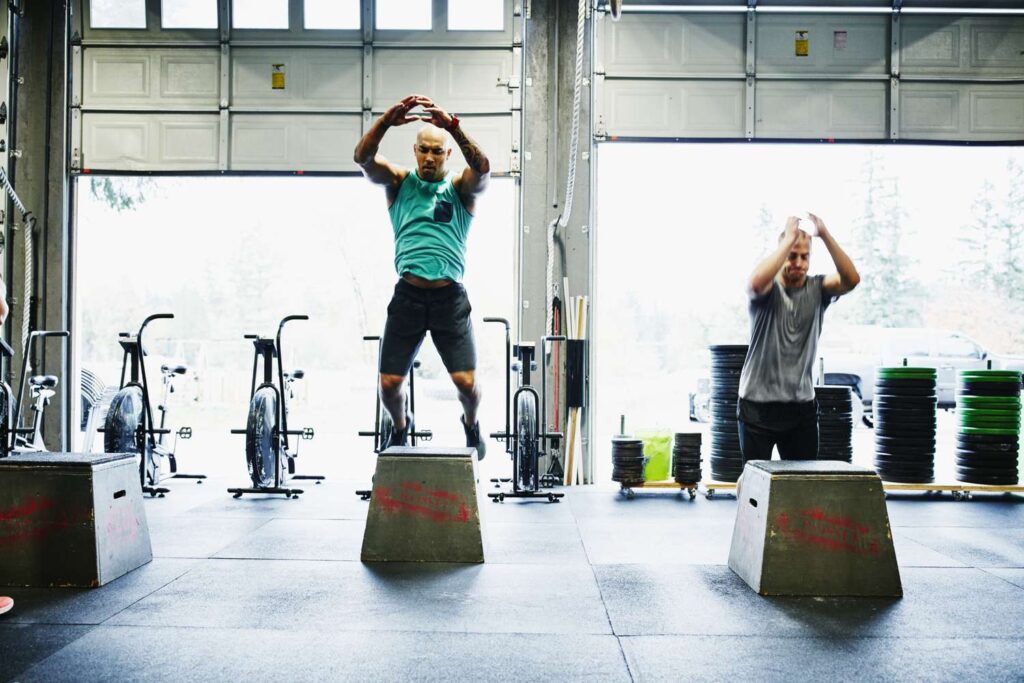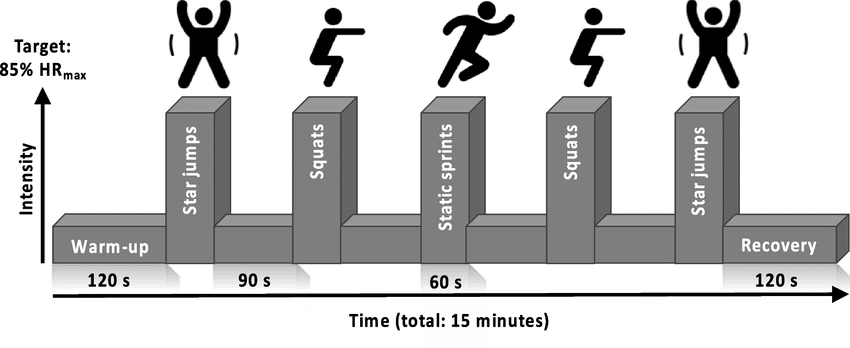The search for streamlined and impactful fitness regimens has never been more pronounced in a rapidly evolving world where time is precious. Among the countless exercise practices, one particular approach is gaining traction for its remarkable ability to yield impressive results in a minimal time frame – High Intensity Training (HIT).
High-intensity training goes beyond being merely a workout; it embodies a philosophy that challenges traditional perceptions of fitness. It wholeheartedly embraces the notion that the key to unlocking the body’s full potential lies in intensity, not duration.
This article takes a deep dive into the principles, benefits, and scientific underpinnings of this groundbreaking form of exercise, shedding light on how it has revolutionized individuals’ approaches to their fitness journeys.

As we embark on this exploration of High-Intensity Training, anticipate delving into a world where every passing second is important. It’s a space where the body is relentlessly pushed to its limits, and the pursuit of fitness undergoes an era shift, placing emphasis on the intensity of effort rather than the duration spent in the gym.
Get ready to unleash your complete potential as we unravel the secrets and science behind High-Intensity Training – a fitness revolution that is reshaping the landscape for those in search of a more efficient and results-driven approach to their workouts.
Read Also: What Is Premature Electrification?
What Is High Intensity Training?

High-intensity training (HIT) is a workout philosophy and method that focuses on short bursts of intense, all-out effort during exercise, followed by periods of rest or lower intensity.
The fundamental principle behind HIT is to maximise the benefits of a workout in a condensed timeframe by pushing the body to its limits during short but highly intense intervals.
Key features of High Intensity Training include:
- Short Duration: HIT sessions are typically shorter compared to traditional workouts. The emphasis is on the quality of effort rather than the quantity of time spent exercising.
- Maximum Effort: During the intense intervals, individuals are encouraged to exert themselves at or near their maximum capacity. This could involve lifting heavy weights, performing explosive movements, or engaging in high-intensity cardiovascular exercises.
- Interval Structure: HIT often incorporates interval training, which alternates between periods of intense exercise and rest or lower-intensity activity. This approach helps to maximize calorie burn, improve cardiovascular fitness, and build strength in a time-efficient manner.
- Adaptability: High-intensity training can be adapted to various forms of exercise, including weightlifting, bodyweight exercises, and cardiovascular activities such as sprinting or cycling.
- Metabolic Impact: The intensity of HIT workouts has been shown to boost metabolism, both during and after the exercise session. This is known as the afterburn effect or excess post-exercise oxygen consumption (EPOC), where the body continues to burn calories at an elevated rate post-exercise.
- Efficiency: HIT is valued for its time efficiency, making it an attractive option for individuals with busy schedules. The goal is to achieve significant fitness gains with shorter, more focused workouts.
- Adaptation and Progression: HIT often involves progressive overload, where individuals gradually increase the intensity of their workouts over time. This can be achieved by increasing the resistance, duration, or complexity of exercises.
It’s important to note that while HIT can be highly effective, it may not be suitable for everyone. Individuals with certain health conditions or beginners who want to exercise should consult with a fitness professional or healthcare provider before incorporating high-intensity training into their routine.
HIT stands as a dynamic and results-driven approach to fitness, challenging traditional notions and providing a pathway for those seeking efficient, impactful workouts.
Related: How Much Is Liposuction? (Everything you shouid know)
8 Factors to Consider for High-Intensity Training Workouts
When engaging in High-Intensity Training (HIT), it’s crucial to consider several factors to optimize your workouts, enhance safety, and achieve the best results. Here are eight key factors to keep in mind:

- Health and Fitness Level:
- Before embarking on a High-Intensity Training program, assess your current health and fitness level. If you have any pre-existing health conditions or concerns, consult with a healthcare professional or fitness expert to ensure that HIT is appropriate for you.
- Warm-up and Cool-down:
- Warm up adequately before diving into high-intensity exercises. A proper warm-up prepares your body for the intense effort and helps prevent injuries. Similarly, incorporate a cool-down routine to gradually lower your heart rate and ease your body out of the intense workout.
- Progression:
- High-intensity training often involves progressive overload. Gradually increase the intensity, whether through heavier weights, more challenging exercises, or shorter rest periods. This progression is essential for continued improvements and to prevent plateaus in your fitness journey.
- Intensity and Form:
- Maintain proper form during high-intensity exercises to reduce the risk of injury. While intensity is crucial for HIT, it should not compromise your form. Focus on performing each movement with precision, even during the most intense intervals.
- Rest and Recovery:
- Adequate rest and recovery are essential for maximizing the benefits of HIT. Overtraining can lead to fatigue, decreased performance, and an increased risk of injury. Incorporate rest days into your routine, prioritize quality sleep, and consider techniques like stretching or foam rolling to aid recovery.
- Individualization:
- HIT can be tailored to individual preferences and goals. Consider your specific fitness objectives, whether they involve building strength, improving cardiovascular fitness, or a combination of both. Customize your HIT program to align with your personal fitness aspirations.
- Nutrition:
- Proper nutrition plays a crucial role in supporting high-intensity workouts. Ensure you have sufficient energy reserves by consuming a balanced diet that includes carbohydrates, proteins, and healthy fats. Stay hydrated before, during, and after your workouts to optimize performance and recovery.
- Monitoring and Listen to Your Body:
- Pay attention to how your body responds to high-intensity exercise. Listening to your body and adjusting your workouts accordingly is essential if you experience excessive fatigue, pain, or discomfort beyond normal muscle soreness. Regularly monitor your progress and make adjustments to your HIT routine as needed.
By considering these factors, you can design a High-Intensity Training program that aligns with your fitness goals while prioritizing safety and sustainability. Whether you’re a seasoned athlete or new to fitness, a thoughtful approach to these aspects will contribute to a more effective and enjoyable HIT experience.
Read: 7 Natural Ways To Prevent Cancer
8 Benefits of High Intensitive Training
High-intensity training (HIT) offers a range of benefits that make it an attractive and efficient workout option for individuals seeking transformative results in a shorter time frame. Here are eight notable benefits of incorporating High-Intensity Training into your fitness routine:
- Efficiency:
- HIT is time-efficient, making it ideal for individuals with busy schedules. The focus on short, intense bursts of exercise followed by rest periods allows for effective workouts in less time compared to traditional, longer-duration workouts.
- Calorie Burn and Fat Loss:
- The intense nature of HIT workouts, coupled with the afterburn effect (excess post-exercise oxygen consumption or EPOC), leads to increased calorie burn even after the workout is complete. This can contribute to fat loss and improved body composition.
- Cardiovascular Health:
- High-intensity training is effective in improving cardiovascular health by challenging the heart and circulatory system. The interval structure of HIT can enhance cardiovascular endurance and promote better heart health.
- Metabolic Boost:
- HIT has been shown to boost metabolism, which can contribute to weight management. The increased metabolic rate post-exercise helps the body continue to burn calories at an elevated rate, promoting fat oxidation and lean muscle development.
- Muscle Building and Strength:
- Despite its shorter duration, HIT can be highly effective for building muscle and increasing strength. The intensity of the exercises stimulates muscle growth and enhances strength, especially when combined with progressive overload over time.
- Adaptability:
- HIT can be adapted to various fitness levels and preferences. Whether you prefer weightlifting, bodyweight exercises, or cardiovascular activities, the principles of high-intensity effort followed by rest can be applied across different modalities.
- Improves Insulin Sensitivity:
- High-intensity training has been linked to improved insulin sensitivity. This is beneficial for managing blood sugar levels, reducing the risk of type 2 diabetes, and promoting overall metabolic health.
- Mental Benefits:
- The intense focus required during HIT workouts can have positive effects on mental health. The release of endorphins, often referred to as “feel-good” hormones, can contribute to reduced stress, improved mood, and increased overall mental well-being.
It’s important to note that while High-Intensity Training offers numerous benefits, it may not be suitable for everyone. Individuals with certain health conditions or those new to exercise should consult with a healthcare professional or fitness expert before incorporating HIT into their routine.
Additionally, proper form, warm-up, and recovery practices should be emphasized to ensure safety and maximize the benefits of this dynamic workout approach.
Conclusion
High-intensity training (HIT) represents a dynamic and transformative fitness paradigm, presenting many advantages within a condensed timeframe. HIT has evolved into a cornerstone for those pursuing results from its efficiency and time-effectiveness to its impact on fat loss, muscle development, and cardiovascular health.
HIT’s versatility across various exercise modalities allows individuals to customize their workouts based on personal preferences and fitness objectives.
Whether drawn to the heightened metabolic rates, enhanced insulin sensitivity, or the mental well-being associated with endorphin release, HIT transcends being a mere workout—it embodies a holistic approach to health and fitness.
Nevertheless, a judicious approach to High-Intensity Training is imperative, considering individual fitness levels, health conditions, and maintaining proper form. The significance of safety, warm-up routines, and recovery practices should never be underestimated, underscoring the need for a comprehensive fitness strategy.
In the ever-evolving health and wellness landscape, High-Intensity Training stands out as a guiding light for those aiming to maximize their fitness potential in a time-pressed world.
Whether you’re a seasoned fitness enthusiast or embarking on a wellness journey, the principles of HIT provide a route to efficient, effective, and impactful workouts, ushering in a new era of fitness that prioritizes intensity over duration.
See Also: What is Body Count?
FAQs for High-intensity Training
What is an example of a high-intensity workout?
Using a stationary bike, pedal as hard and fast as possible for 30 seconds. Then, pedal at a slow, easy pace for 2–4 minutes. Repeat this pattern for 15–30 minutes.
What are the 4 types of high-intensity interval training?
Cardio HIIT.
HIIT with weights.
Bodyweight HIIT.
Full body HIIT.
What is an example of intensity training?
The types of activity that require vigorous effort for most people include: jogging or running.
How long is high-intensity training?
The total duration of a HIIT session should be about 30-60 minutes in length, with warm-up and cool-down included.





